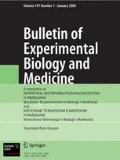Clinical and morphological comparison of wound healing after transplantation of living cultured allofibroblast on days 1–2 after the injury, collagen-1-based dressing with PDGF-BB, and traditional dressing with levomecol ointment showed that bioactive dressing accelerated wound epithelialization (5–7 days vs. 20–22 days with gauze dressing); the incidence of suppurative complications decreased, no crust formed, and epithelialization was not associated with the formation of a hypertrophic cicatrix. Biological dressing based on living cultured allofibroblasts and collagen-1 with PDGF-BB exhibited equal stimulatory effects on burn wound healing.
Similar content being viewed by others
References
I. V. Voronkina, N. V. Kalmykova, and G. P. Pinaev, Tsitologiya, 46, No. 4, 361–375 (2004).
A. S. Ermolov, S. V. Smirnov, V. B. Khvatov, et al., Skoraya Pomoshch', No. 3, 171–172 (2006).
E. G. Kolokolchikova, L. I. Budkevich, A. E. Bobrovnikov, et al., Byull. Eksp. Biol. Med., 131, No. 1, 107–111 (2001).
Methodological Recommendations of Ministry of Health of the Russian Federation “Method for Surgical Treatment of Burns in Children by Using Cultured Human Allofibroblasts”, Moscow (1997).
D. S. Sarkisov, A. A. Alekseev, V. P. Tumanov, et al., New Methods for Treatment of Burns Using Cultured Allofibroblasts [in Russian], Saratov (1998), p. 31.
M. Z. Aberdin and R. Riemschneider, Die Angewandte Makromolekulare Chemie, 11, No. 1701, 107–122 (1983).
L. Alonso and E. Fuchs, PNAS, 100, Suppl. 1, 11,830–11,835 (2003).
R. A. Clark, J. Dermatol. Surg. Oncol., 19, No. 8, 693–706 (1993).
A. el-Ghalbzouri, S. Gibbs, E. Lamme, et al., Brit. J. Dermatol., 147, No. 2, 230–243 (2002).
A. K. Ghosh, Exp. Biol. Med., 227, No. 5, 301–314 (2002).
M. Ito, Y. Liu, Z. Yang, et al., Nature Med., No. 11, 1351–1354 (2005).
D. A. Lauffenburger and A. F. Horwitz, Cell, 84, No. 3, 359–369 (1996).
W. Li, J. Fan, M. Chen, et al., Mol. Biol. Cell, 15, No. 1, 294–309 (2004).
P. Libby and R. T. Lee, Circulation, 102, 1874–1876 (2000).
C. F. Roufosse, N. C. Direkze, W. R. Otto, and N. A. Wright, Inter. J. Biochem. Cell. Biol., 36, 585–597 (2004).
S. Werner and R. Grose, Physiol. Rev., 83, 835–870 (2003).
Author information
Authors and Affiliations
Corresponding author
Additional information
Translated from Kletochnye Tehnologii v Biologii i Medicine, No. 3, pp. 166–170, August, 2008
Rights and permissions
About this article
Cite this article
Ermolov, A.S., Smirnov, S.V., Khvatov, V.B. et al. The use of bioactive wound dressing, stimulating epithelial regeneration of IIIa-degree burn wounds. Bull Exp Biol Med 146, 153–157 (2008). https://doi.org/10.1007/s10517-008-0225-0
Received:
Published:
Issue Date:
DOI: https://doi.org/10.1007/s10517-008-0225-0




